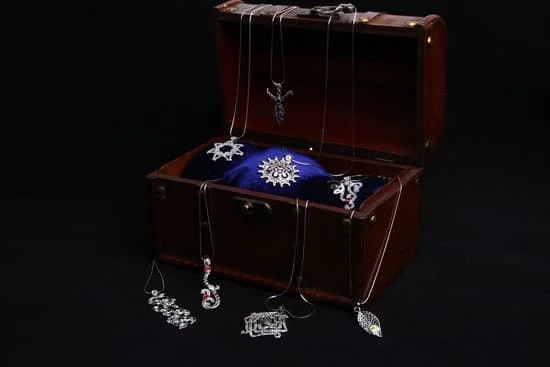Man-made diamonds have been gaining popularity in the jewelry industry, and this article aims to explore whether jewelry stores are selling them. With advancements in technology, man-made diamonds have become a viable option for consumers who are seeking ethical and sustainable alternatives to natural diamonds. In this introductory section, we will delve into the reasons behind the growing popularity of man-made diamonds and discuss how the jewelry industry has adapted to meet the demand.
In recent years, there has been a significant shift in consumer preferences towards more sustainable and ethical choices when it comes to purchasing luxury goods. This movement has extended to the diamond industry as well, with more individuals opting for man-made diamonds over their natural counterparts.
Man-made diamonds are grown in laboratories using advanced technology that replicates the natural diamond formation process. The result is a visually identical diamond that possesses all the physical and chemical properties of a natural diamond.
The increasing awareness about issues such as unethical mining practices, social injustice, and environmental concerns associated with natural diamond mining has fueled the demand for man-made diamonds. Consumers today are conscious of where their products come from and want assurances that they are making responsible choices.
Jewelry stores have recognized this shift in consumer sentiment and have started offering man-made diamonds as part of their collections. By doing so, they not only cater to the evolving preferences of their customers but also contribute to a more sustainable future for the jewelry industry.
Understanding the Difference between Natural and Man-made Diamonds
When it comes to diamonds, there are two main types available in the market: natural diamonds and man-made diamonds. Understanding the differences and similarities between these two types is crucial for consumers to make an informed decision when purchasing diamond jewelry.
One of the primary distinctions between natural and man-made diamonds lies in their origin. Natural diamonds are formed deep within the Earth’s mantle under intense heat and pressure over millions of years. These diamonds are then brought to the Earth’s surface through volcanic activity. On the other hand, man-made diamonds, also known as lab-grown or synthetic diamonds, are created in a laboratory using advanced technology that replicates the conditions under which natural diamonds form.
In terms of physical properties, both natural and man-made diamonds possess identical characteristics. They have the same chemical composition (pure carbon), crystal structure, hardness, brilliance, and durability. This means that from an aesthetic standpoint, it is nearly impossible for individuals to distinguish between natural and man-made diamonds with their naked eye alone. Specialized equipment is required to differentiate them accurately.
Despite these similarities, there are a few ways in which experts can identify whether a diamond is natural or man-made. For instance, when viewed under high magnification, some lab-grown diamonds might exhibit specific growth patterns that differ from those found in natural stones. Additionally, certain inclusion types or specific indications of treatments can provide clues about a diamond’s origin. However, it should be noted that these identification methods require expertise and specialized tools to carry out effectively.
Understanding these distinctions empowers consumers with knowledge about their options when considering a diamond purchase. Whether they choose a dazzling natural diamond or an equally stunning man-made creation, they can now make an informed decision based on their preferences and priorities.
The Benefits of Man-made Diamonds for Consumers
The popularity of man-made diamonds in the jewelry industry has been growing steadily over the years. This section will delve into the benefits of man-made diamonds for consumers, which have led to an increasing number of individuals opting for these ethical and environmentally friendly alternatives.
One of the key advantages of man-made diamonds is their ethical sourcing. Unlike natural diamonds, which are often associated with unethical practices such as child labor and environmental damage, man-made diamonds are created in controlled laboratory environments. This means that consumers can rest assured knowing that their purchase is free from any ethical concerns. Additionally, man-made diamonds are also conflict-free, as they do not contribute to the issue of blood or conflict diamonds.
Another benefit of choosing man-made diamonds is their positive environmental impact. The process of mining natural diamonds often causes extensive damage to land and ecosystems, including deforestation and soil erosion. In contrast, lab-grown diamonds have a significantly lower carbon footprint since they do not require extensive mining operations. This makes them a more sustainable choice for environmentally conscious consumers who want to minimize their ecological impact.
In addition to being ethically and environmentally preferable, man-made diamonds also offer consumers greater value for money compared to natural diamonds. Traditional natural diamonds are priced higher due to their rarity and the costs associated with mining and distribution.
On the other hand, man-made diamonds can be produced at a fraction of the price since they do not require extensive mining operations or face supply constraints. This allows consumers to purchase larger or higher-quality stones within their budget.
Overall, the benefits of man-made diamonds for consumers are clear: ethical sourcing, environmental sustainability, and better value for money. As more individuals become aware of these advantages, it is no surprise that there is a growing trend in jewelry stores offering man-made diamond options in their collections. By choosing man-made diamonds, consumers can not only enjoy beautiful and high-quality jewelry but also contribute to a more ethical and sustainable industry.
Evolution of the Jewelry Industry
The evolution of the jewelry industry has been marked by a significant shift towards offering man-made diamonds in their collections. As consumers become more conscious of ethical and environmental concerns, the demand for sustainable and conflict-free alternatives to natural diamonds has soared. In response to this growing trend, jewelry stores have adapted their business models to cater to these changing preferences.
Redefining Value: Ethical and Environmental Concerns
One of the key factors that have led to the inclusion of man-made diamonds in jewelry store collections is the rising concern for ethical sourcing. Natural diamonds often come with a history of human rights abuses and environmental damage through practices like mining.
Many consumers are now actively seeking alternatives that are sourced in an ethical and sustainable manner. Man-made diamonds offer just that – they are created in laboratories under controlled conditions, eliminating the need for mining and ensuring a conflict-free origin.
Moreover, man-made diamonds also address environmental concerns. The diamond mining process can cause extensive damage to ecosystems, including deforestation, soil erosion, and water pollution. By opting for man-made diamonds, consumers reduce their impact on the environment and contribute to a more sustainable future.
Jewelry Stores as Champions of Sustainability
Recognizing the shifting consumer preferences towards sustainability and ethics, jewelry stores have stepped up to meet this demand. Leading brands have started including man-made diamonds in their collections alongside natural ones. These businesses understand that by offering an ethically responsible alternative, they not only attract customers who prioritize sustainability but also contribute to shaping a more responsible industry as a whole.
Jewelry stores have invested in research and development to ensure they can provide high-quality man-made diamonds that are indistinguishable from natural ones in terms of brilliance and beauty. Through close collaboration with laboratories that specialize in creating man-made diamonds, these stores have become champions of sustainability by diversifying their offerings while maintaining strict quality control standards.
Leading Jewelry Stores Selling Man-made Diamonds
As the demand for man-made diamonds continues to grow, many jewelry brands and stores have recognized the trend and started offering these lab-grown gems in their inventory. This shift is driven by various factors, including the ethical and environmental benefits of man-made diamonds, as well as their increasing popularity among consumers. Here are some leading jewelry stores that are now selling man-made diamonds:
- Tiffany & Co.: Renowned for its luxury diamond jewelry, Tiffany & Co. has recently introduced a collection featuring man-made diamonds. The brand values sustainability and transparency, making man-made diamonds a natural addition to their offerings.
- Brilliant Earth: Known for its ethically sourced gemstones, Brilliant Earth has fully embraced the concept of lab-grown diamonds. They offer a wide range of engagement rings, wedding bands, and other fine jewelry pieces featuring these sustainable alternatives.
- James Allen: With a reputation for providing high-quality diamond jewelry at competitive prices, James Allen has also recognized the potential of man-made diamonds. They offer a selection of engagement rings with both lab-grown and natural diamond options, allowing customers to choose according to their preferences.
- Blue Nile: As one of the largest online retailers of certified diamonds, Blue Nile now offers a collection of lab-created diamond engagement rings and other fine jewelry pieces. They emphasize the affordability and customization options available with man-made diamonds.
These are just a few examples of leading jewelry stores that have incorporated man-made diamonds into their collections. It’s worth noting that this list continues to grow as more brands recognize the demand for ethical and sustainable alternatives in the industry.
| Jewelry Store | Type of Diamonds Offered |
|---|---|
| Tiffany & Co. | Lab-grown diamonds |
| Brilliant Earth | Lab-grown diamonds |
| James Allen | Both lab-grown and natural diamonds |
| Blue Nile | Lab-grown diamonds |
These leading jewelry stores have responded to the changing preferences of consumers by offering man-made diamonds alongside their traditional offerings. This allows customers to make an informed choice based on their personal values and desires, contributing to a more sustainable and ethical future for the jewelry industry.
The Process of Creating Man-made Diamonds
Man-made diamonds, also known as lab-grown or synthetic diamonds, have gained significant popularity in the jewelry industry in recent years. This section will provide an insight into the technology and techniques used to manufacture these diamonds in laboratories.
The process of creating man-made diamonds involves replicating the conditions that occur deep within the Earth’s mantle where natural diamonds are formed. This can be achieved using two main methods: High Pressure High Temperature (HPHT) and Chemical Vapor Deposition (CVD).
In HPHT method, a small diamond seed is placed in a press that simulates high pressure and temperature conditions. Carbon, in the form of graphite, is then added along with a metal catalyst such as iron or nickel. The combination of pressure, temperature, and carbon causes the growth of new crystals around the diamond seed.
On the other hand, CVD involves placing a diamond seed in a sealed chamber and introducing a mixture of gases comprising carbon-rich molecules such as methane and hydrogen. These gases are then ionized using microwaves or hot filament to break them down into their elemental components. The carbon atoms then bond together on the surface of the diamond seed, slowly building up layer by layer to create a larger diamond crystal.
Both methods require careful control of various factors including pressure, temperature, gas composition, and growth time to produce high-quality man-made diamonds. The entire process can take anywhere from several days to several weeks depending on the desired size and quality of the diamond.
It is important to note that while man-made diamonds have identical physical and chemical properties to natural diamonds, they are distinguishable through advanced testing techniques. For instance, specialized equipment can examine certain unique growth patterns or impurities present in man-made diamonds which are not found in natural ones.
How to Identify Man-made Diamonds
Identifying man-made diamonds from natural ones can be a challenge for consumers. However, there are several methods that can help distinguish between the two, ensuring that buyers make informed purchases. It is important to note that man-made diamonds possess nearly identical physical and chemical properties as natural diamonds, making it difficult to differentiate them with the naked eye. To aid consumers in this process, here are some effective ways to identify man-made diamonds:
- Laser Inscription: Some man-made diamond manufacturers laser-inscribe their diamonds with a unique serial number or logo on the girdle of the stone. This inscription helps to verify the origin of the diamond and distinguishes it from natural ones.
- Diamond Certification: Both natural and man-made diamonds can be certified by reputable gemological laboratories such as GIA (Gemological Institute of America) or IGI (International Gemological Institute). These certificates provide detailed information about the diamond’s characteristics, including its origin.
- Spectroscope/Cross-Polarized Light Testing: Jewelers can use specialized tools like spectrometers or cross-polarized light testing equipment to examine how light interacts with a diamond. Natural diamonds exhibit certain specific optical properties that differ from those of man-made counterparts.
- Color Grading: Man-made diamonds often exhibit color variations that are not commonly found in natural diamonds. By examining the color grade of a diamond, jewelers can sometimes determine whether it is a lab-grown one.
- Price Comparison: In general, man-made diamonds tend to be more affordable than natural ones, especially for larger carat sizes. If a diamond’s price seems too good to be true for its size and quality, it could potentially be a man-made diamond.
By familiarizing themselves with these identification methods and seeking assistance from reputable jewelers or gemologists, consumers can confidently distinguish between man-made and natural diamonds before making their purchase decisions. It is crucial for buyers to understand what they are buying, ensuring that their jewelry aligns with their preferences and values.
Pricing and Value Comparison
The Cost Differences between Natural and Man-made Diamonds
When it comes to pricing, there is a significant disparity between natural and man-made diamonds. Natural diamonds are formed deep within the Earth’s crust over billions of years, making them extremely rare and valuable. As a result, their prices are often much higher compared to man-made diamonds.
On the other hand, man-made diamonds are created in laboratories under controlled conditions, using advanced technology and techniques. This allows for greater control over the production process, resulting in lower costs.
Why Man-made Diamonds Offer Better Value for Money
Despite being less expensive than their natural counterparts, man-made diamonds offer several advantages that make them a better value for money option. Firstly, man-made diamonds have the same physical properties as natural diamonds. They possess the same brilliance, fire, and durability, making them visually indistinguishable from natural diamonds to the untrained eye.
Secondly, choosing a man-made diamond promotes ethical practices in the jewelry industry. As mentioned earlier in the article, man-made diamonds are conflict-free and do not contribute to any human rights violations or environmental damage that can be associated with mining natural diamonds.
Lastly, man-made diamonds offer better price transparency. Since they are produced using scientific methods in laboratories, their prices remain consistent regardless of market fluctuations. This eliminates concerns over price volatility and ensures consumers know exactly what they are paying for.
Considering Factors when Choosing Between Natural and Man-made Diamonds
Although man-made diamonds provide better value for money in many cases, there are instances where natural diamonds may be preferred. For individuals who seek a sense of tradition or want an heirloom piece of jewelry with sentimental value that has been passed down through generations, natural diamonds might be more suitable.
However, for those who prioritize affordability without compromising on quality or wish to make an environmentally conscious choice while still indulging in luxury, man-made diamonds are an ideal option. With their lower price tags and positive ethical attributes, these diamonds offer consumers the opportunity to own stunning jewelry without breaking the bank or compromising on their values.
Consumer Testimonials
One of the best ways to gain insights into the benefits and quality of man-made diamonds is through consumer testimonials. These firsthand accounts can provide detailed experiences and reassurance for potential buyers. Many individuals have chosen to purchase man-made diamonds from jewelry stores and have shared their positive experiences online.
- Sarah, a customer from New York, purchased a stunning man-made diamond engagement ring from a reputable jewelry store. She was initially hesitant about opting for a man-made diamond instead of a natural one. However, after thorough research and consultation with jewelers, she decided to go for it.
Sarah was amazed by the quality and beauty of her ring. She mentioned that it is virtually impossible to distinguish her man-made diamond from a natural one without specialized equipment. Furthermore, she appreciated the ethical aspect of her purchase, knowing that no harm was done to the environment or exploited labor in the process. - Michael, another satisfied customer from California, purchased a pair of man-made diamond earrings for his wife’s birthday. He mentioned that his wife couldn’t be happier with them. Michael highlighted the affordability factor as one of the main reasons he opted for man-made diamonds over natural ones. He stated that he was able to get larger carat sizes within his budget without compromising on quality or sparkle.
- Emily, a fashion-forward consumer from London, decided to purchase several pieces of jewelry adorned with man-made diamonds from a well-known jewelry store. In her testimonial, she expressed her delight about being able to keep up with current trends while staying environmentally conscious and supporting ethically-sourced materials. Emily emphasized that her friends were amazed at the brilliance and beauty of her collection and couldn’t believe they were made in laboratories.
These consumer testimonials provide real-life experiences that showcase not only the quality but also the ethical advantages and affordability that come with purchasing man-made diamonds from jewelry stores. They serve as reassurance for potential buyers who may be considering making the switch to man-made diamonds.
Conclusion
In conclusion, the jewelry industry has experienced a significant shift in recent years with the growing popularity of man-made diamonds. As discussed throughout this article, consumers are increasingly opting for man-made diamonds due to their ethical and environmental advantages. This shift has prompted jewelry stores to adapt to the demand and offer man-made diamonds in their collections.
One of the key benefits for consumers is the reassurance that they are making an ethically responsible purchase. With man-made diamonds, there are no concerns about unethical mining practices or supporting conflict-ridden regions. Additionally, these diamonds have a significantly lower carbon footprint and require less water and energy to produce compared to their natural counterparts.
Jewelry stores have recognized the value of incorporating man-made diamonds into their inventory, as highlighted by leading brands and stores embracing this trend. By offering man-made diamonds, these jewelry stores provide consumers with a wider range of choices that align with their values and preferences.
Overall, the availability of man-made diamonds in jewelry stores has revolutionized the industry. Consumers now have access to more sustainable options without sacrificing quality or beauty. As more individuals share their positive experiences with purchasing man-made diamonds from jewelry stores, it is clear that this trend will continue to thrive. So whether you prioritize ethics, sustainability, or simply want the best value for your money, consider exploring the world of man-made diamonds at your favorite jewelry store.
Frequently Asked Questions
Can you buy man made diamonds?
Yes, it is possible to buy man-made diamonds. Man-made diamonds, also known as lab-grown or synthetic diamonds, are created in a laboratory setting using advanced technology that simulates the natural process of diamond formation.
These diamonds have the same chemical and physical properties as natural diamonds but are made in a controlled environment instead of being mined from the earth. They offer an alternative to naturally occurring diamonds and can often be more affordable.
Can a jeweler tell if a diamond is man made?
In most cases, jewelers can tell if a diamond is man-made or natural by examining it using specialized equipment. While man-made diamonds share many characteristics with natural diamonds, there are certain differences that can be detected through various testing methods.
For example, trained gemologists may use machines that analyze light reflection patterns or measure thermal conductivity to determine whether a diamond is lab-grown or natural. However, it is important to note that high-quality man-made diamonds can be very difficult to differentiate from natural ones without proper testing.
Do Zales sell fake diamonds?
Zales is a reputable jewelry retailer that does not sell fake diamonds intentionally. They are known for their extensive selection of engagement rings, wedding bands, and other fine jewelry items. Zales seeks to provide customers with genuine and high-quality gemstones including diamonds.
However, even reputable jewelers like Zales may occasionally encounter mislabeled or misrepresented stones from their suppliers. This can happen due to human error or unintentional mix-ups during the supply chain process. It’s always advisable for customers to ensure they receive proper certification and documentation when purchasing expensive items like diamond jewelry to guarantee its authenticity.

Welcome to my jewelry blog! My name is Sarah and I am the owner of this blog.
I love making jewelry and sharing my creations with others.
So whether you’re someone who loves wearing jewelry yourself or simply enjoys learning about it, be sure to check out my blog for insightful posts on everything related to this exciting topic!





